Tramlink
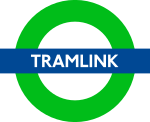 | |
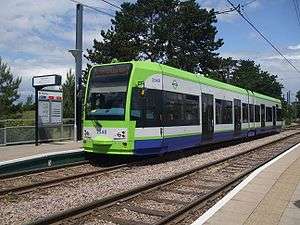 Tram 2548 at Arena | |
 The tram network as of 2016 | |
| Overview | |
|---|---|
| Owner | Transport for London |
| Area served | Bromley, Croydon, Merton, Sutton |
| Locale | South London |
| Transit type | Light rail/Tram |
| Number of stations | 39 |
| Annual ridership |
29.5 million (2016/17)[1] |
| Headquarters |
Tramlink Depot Coomber Way Croydon |
| Website |
www |
| Operation | |
| Began operation | May 2000 |
| Operator(s) | Tram Operations Ltd. |
| Number of vehicles |
23 Bombardier CR4000 12 Stadler Rail Variobahn |
| Technical | |
| System length | 28 km (17 mi) |
| Track gauge | 1,435 mm (4 ft 8 1⁄2 in) standard gauge |
| Electrification | Overhead line (750 V DC) |
| Top speed | 50 miles per hour (80 km/h) |
Tramlink is a light rail tram system serving Croydon and surrounding areas in South London, England. It began operation in 2000, the first tram system in London since 1952. It is owned by London Trams, an arm of Transport for London (TfL), and operated by Tram Operations Ltd. a subsidiary of FirstGroup.[2]
The network consists of 39 stops along 28 km (17 mi) of track,[3] on a mixture of street track shared with other traffic, dedicated track in public roads, and off-street track consisting of new rights-of-way, former railway lines, and one right-of-way where the Tramlink track parallels a third rail-electrified Network Rail line.
The network's lines coincide in central Croydon, with eastbound termini at Beckenham Junction, Elmers End and New Addington, and a westbound terminus at Wimbledon, where there is an interchange for London Underground. Tramlink is the fourth-busiest light rail network in the UK behind Manchester Metrolink, Tyne and Wear Metro and the Docklands Light Railway.
History
Construction
._-_geograph.org.uk_-_1660811.jpg)
In 1990 Croydon Council with London Regional Transport (LRT) put the project to Parliament and the Croydon Tramlink Act 1994 resulted, which gave LRT the power to build and run Tramlink.[4]
In 1996 Tramtrack Croydon Limited (TCL) won a 99-year Private Finance Initiative (PFI) contract to design, build, operate and maintain Tramlink. The equity partners in TCL were Amey (50%), Royal Bank of Scotland (20%), 3i (20%) and Sir Robert McAlpine with Bombardier Transportation contracted to build and maintain the trams and FirstGroup operate the service.[5][6] TCL retained the revenue generated by Tramlink and LRT had to pay compensation to TCL for any changes to the fares and ticketing policy introduced later.[7]
One of the factors leading to its creation was that the London Borough of Croydon has no London Underground service.[8]
Former lines reused
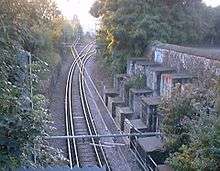
Tramlink makes use of a number of National Rail lines, running parallel to franchised services, or in some cases, runs on previously abandoned railway corridors. Between Birkbeck and Beckenham Junction, Tramlink uses the Crystal Palace line, running alongside Southern rail services. The National Rail track had been singled some years earlier.[9] From Elmers End to Woodside, Tramlink follows the former British Rail branch line to Woodside where the old station buildings stand disused, and the original platforms have been replaced by accessible low platforms. Tramlink then follows the former Woodside and South Croydon Railway to reach the current Addiscombe tram stop, adjacent to the site of the demolished Bingham Road railway station. It continues along the former railway route to near Sandilands where Tramlink curves sharply towards Sandilands tram stop. Another route from Sandilands tram stop curves sharply on to Woodside and South Croydon Railway before passing through Park Hill (or Sandilands) tunnels and to the site of Coombe Road railway station after which it curves away across Lloyd Park.
Tramlink follows the former West Croydon to Wimbledon Line, which was first opened in 1855 and closed on 31 May 1997 to allow for conversion into Tramlink.[10] Within this section, from near Phipps Bridge to near Reeves Corner, Tramlink follows the Surrey Iron Railway, giving Tramlink a claim to one of the world's oldest railway alignments – Tramway Path beside Mitcham tram stop. A partial obstruction near this point (reinforcement to a retaining wall below a car park) has necessitated the use of interlaced track.
A Victorian footbridge beside Waddon New Road was dismantled to make way for the flyover[11] over the West Croydon to Sutton railway line. The footbridge has been re-erected at Corfe Castle station on the Swanage Railway (although some evidence suggests that this was a similar footbridge removed from the site of Merton Park Railway Station).[12][13]
Buyout by Transport for London
In March 2008, TfL announced that it had reached agreement to buy TCL for £98m. The purchase was finalised on 28 June 2008.[14] The background to this purchase relates to the requirement that TfL (who took over from London Regional Transport in 2000) compensates TCL for the consequences of any changes to the fares and ticketing policy introduced since 1996. In 2007 that payment was £4m, with an annual increase in rate.[7]
In October 2008 TfL introduced a new livery, using the blue, white and green of the routes on TfL maps, to distinguish the trams from buses operating in the area. The colour of the cars was changed to green, and the brand name was changed from Croydon Tramlink to simply Tramlink.[15] These refurbishments were completed in early 2009.
Current system
Stops

The tram stops have low platforms, 35 cm (14 in) above rail level. They are unstaffed and had automated ticket machines that are no longer in use due to TfL making trams cashless. In general, access between the platforms involves crossing the tracks by pedestrian level crossing. There are 39 stops, most being 32.2 m (106 ft) long. They are virtually level with the doors and are all wider than 2 m (6 ft 7 in). This allows wheelchairs, prams, pushchairs and the elderly to board the tram easily with no steps. In street sections, the stop is integrated with the pavement.
Tramlink uses some former main-line stations on the Wimbledon–West Croydon and Elmers End–Coombe Lane stretches of line. The railway platforms have been demolished and rebuilt to Tramlink specifications, except at Elmers End and Wimbledon where the track level was raised to meet the higher main-line platforms to enable cross-platform interchange.
Thirty-eight stops opened in the phased introduction of tram services in May 2000. Centrale tram stop in Tamworth Road opened on 10 December 2005, increasing journey times slightly. As turnround times were already quite tight this raised the issue of buying an extra tram to maintain punctuality. Partly for this reason but also to take into account the planned restructuring of services (subsequently introduced in July 2006), TfL issued tenders for a new tram. However, nothing resulted from this.
All stops have disabled access, raised paving, CCTV, a Passenger Help Point, a Passenger Information Display (PID), litter bins, a ticket machine, a noticeboard and lamp-posts, and most also have seats and a shelter.
The PIDs display the destinations and expected arrival times of the next two trams. They can also display any message the controllers want to display, such as information on delays or even instructions to vandals to stop placing objects on the track.
Routes

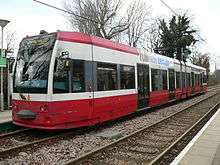

.jpg)
Tramlink has been shown on the principal tube map since 1 June 2016, having previously appeared only on the "London Connections" map.
When Tramlink first opened it had three routes: Line 1 (yellow) from Wimbledon to Elmers End, Line 2 (red) from Croydon to Beckenham Junction, and Line 3 (green) from Croydon to New Addington.[16] On 23 July 2006 the network was restructured, with Route 1 from Elmers End to Croydon, Route 2 from Beckenham Junction to Croydon and Route 3 from New Addington to Wimbledon. In June 2012 Route 4 from Therapia Lane to Elmers End was introduced. On Monday 4 April 2016, Route 4 was extended from Therapia Lane to Wimbledon.[17]
On 25 February 2018, the network and timetables were restructured again for more even and reliable services. As part of this change, trams would no longer display route numbers on their dot matrix destination screens.[18] This resulted in three routes:
- New Addington to West Croydon, returning to New Addington every 6/7 minutes.
- Wimbledon to Beckenham Junction every 10 minutes(every 15 minutes on Sundays and late evening)
- Wimbledon to Elmers End every 10 minutes(every 15 minutes on Sundays and terminates at Croydon in late evening every 15 minutes)
Additionally, the first two trams from New Addington will run to Wimbledon. Overall, this would result in a decrease in 2tph leaving Elmers End, resulting in a 25% decrease in capacity here, and 14% in the Addiscombe area.[19] However, this would also regulate waiting times in this area and on the Wimbledon branch to every 5 minutes, from every 2–7 minutes.[20]
|
|
|
Fares and ticketing
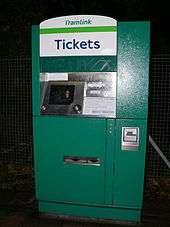
TfL Bus Passes are valid on Tramlink, as are Travelcards that include any of zones 3, 4, 5 and 6.
Pay-as-you-go Oyster Card fares are the same as on London Buses, although special fares may apply when using Tramlink feeder buses.
When using Oyster Cards, passengers must touch in on the platform before boarding the tram. Special arrangements apply at Wimbledon station, where the Tramlink stop is within the National Rail and London Underground station, where Tramlink passengers must touch in at the station entry barriers then again at the Tramlink platform to inform the system that no mainline/LUL rail journey has been made.
Ticket machines are no longer available as of 16 July 2018.
Feeder buses
Bus routes T31, T32 and T33 used to connect with Tramlink at the New Addington, Fieldway and Addington Village stops. T31 and T32 no longer run, and T33 has been renumbered as 433.
Rolling stock
Tramlink is operated with 36 passenger vehicles.[21] The original fleet comprised 24 articulated low floor Flexity Swift CR4000 trams built by Bombardier Transportation in Vienna numbered beginning at 2530, continuing from the highest-numbered tram 2529 on London's former tram network, which closed in 1952. In 2006, the CR4000 fleet was refurbished, with the bus-like destination blinds being replaced by an electronic dot system. In 2009 the fleet was repainted into a new green livery.[22]
In January 2011, Tramtrack Croydon opened a tender for the supply of ten new or second-hand trams from the end of summer 2011.[23] The trams will be used between Therapia Lane and Elmers End.[24][25] On 18 August 2011, TfL announced that Stadler Rail had won a $19.75 million contract to supply six Variobahn trams similar to those used by Bybanen in Bergen, Norway.[25] They entered service in 2012.[26] In August 2013, TfL ordered an additional four Variotrams for delivery in 2015, for use on the Wimbledon to Croydon link, an order which was later increased to six. This brought the total Variotram fleet up to ten in 2015,[26][27] and twelve in 2016 when the final two trams were delivered.[21]
Tram 2535 (the first to travel on the Croydon network under its own power) carries a nameplate in honour of Stephen Parascandolo, the founder of the unofficial Croydon Tramlink website, who was tragically killed in a road accident at the age of 26.[28]
| Class | Image | Top speed | Number | Built | Fleet Numbers | |
|---|---|---|---|---|---|---|
| mph | km/h | |||||
| CR4000 | 50 | 80 | 24 | 1998–2000 | 2530–2553 | |
| Variobahn[29] | 50 | 80 | 6 | 2011–2012 | 2554-2559 | |
| 6 | 2014–2016 | 2560-2565 | ||||
Engineering vehicles
Engineers' vehicles used in Tramlink construction were hired for that purpose. In November 2006 Croydon Tramlink purchased five second-hand engineering vehicles from Deutsche Bahn. These were two DB class Klv 53 engineers' trams (numbered 058 and 059 in Tramline service), and three 4-wheel wagons (numbered 060, 061, and 062).[30] Service tram 058 and trailer 061 were both sold to the National Tramway Museum in 2010.
Future developments
Trams 2030
In November 2014, a 15-year plan for upgrades to the tram system to greatly increase capacity on the network in line with an expected increase in ridership to 60 million passengers by 2031.[31] The plans would relieve overcrowding and improve reliability on all lines, support housing growth, (as laid out in the London Plan) [32] and support programmes for regeneration in the Croydon metropolitan centre (such as Croydon Vision 2020, the Croydon Opportunity Area, and Westfield Croydon); furthermore, the upgrades seek to future-proof for Crossrail 2, potential Bakerloo line extension to the east of the network, and extensions to the tram network itself. The plans involve dual-tracking across the network and introducing diverting loops on either side of Croydon, allowing for a higher frequency of trams on all four branches of the network without increasing congestion in Croydon metropolitan centre; the £737m investement programme is to be funded partially by the Croydon Growth Zone, TfL Business Plan, housing levies, and the respective boroughs, as well as partially by the affected developers.[33] The plans are outlined in three phases consisting of six outputs:
Phase A
To support developments in Croydon, construction of a diverting loop in East Croydon has been proposed at Dingwall Road. This loop would run up Dingwall Road alongside the Ruskin Square development, call at a new stop on Lansdowne Road, and return to the Croydon loop before the Wellesley Road stop (refurbished to accommodate for higher ridership); services originating from New Addington would alternate between using the main Croydon loop and this loop before returning to New Addington, although the services around the Croydon loop may be phased out.[34][31] The aim of this is to increase the number services both around the Croydon loop and to Wimbledon originating from Elmers End to meet demand; to accommodate this increase in services, dual-tracking of line after Arena and the construction of a second platform at Elmers End is required.[31] This is fully committed, partially funded by TfL and partially by the Croydon Partnership of Westfield and Hammerson, with construction to begin in 2017 and to be completed by 2020. However, in the final masterplan planning application approved by Croydon Council and the Mayor of London, commitment by the Croydon Partnership to partially funding the loop was withdrawn, leading TfL and Croydon Council to review the affordability of the scheme.[35] In May 2018, it was announced a third of the cost for Elmers End improvements would be funded from the TfL Growth Fund, with work proposed to start later in the year.[36]
Phase B
An increase in capacity westwards from Croydon centre could support housing growth at industrial and commercial areas in the Wandle Valley area; this could help fund the schemes through a housing levy, although this would require changes in planning allocation from both Croydon and Sutton councils.[33] To achieve this, dual-tracking between Beddington Lane and Mitcham Junction and a second platform at Wimbledon was completed in November 2015, allowing for an initial 50% increase in capacity when the network was extended to Wimbledon.[37] To further increase capacity by ~150%, a series of bottlenecks are proposed to be either resolved or avoided: as well as dual-tracking of line at Phipps Bridge and on the Wandle Flyover (between Reeves Corner and Wandle Park), a new route has been proposed between a spur in South Wimbledon or Colliers Wood and a reversing loop in Old Town, Croydon to avoid constraints at Wimbledon station and in Croydon.[33] This line could provide connections to the South Wimbledon/Colliers Wood Area for Intensification and the Northern Line, as well as supporting connections to the proposed South London Metro at Mitcham Junction and West Croydon.[32][33] The new service could initially run between Morden Road and Croydon before being extended to the new spur.[31] New stops would be built in South Wimbledon/Colliers Wood and in Old Town (initially proposed as Frith Road), as well as an additional platform at Reeves Corner for westward services.[31][33] This plan may be in service by 2023.[38]
Phase C
A 25% increase in capacity could be achieved by the introduction of another passing loop on the Beckenham Junction branch; the extra services could either be fed through Croydon centre or around the Dingwall Loop; this could be in place by 2027.[38] Furthermore, if extra capacity is required, tram stops could be lengthened to serve either longer trams or two trams coupled together on services between Wimbledon and Beckenham Junction or Elmers End; however, the expense required as well as issues from lengthening stops in the Croydon centre may prevent this.[31][33] This would be in place by 2029.[38]
Other developments
These developments could see an increase in fleet from 30 to up to 80 trams (depending on whether longer trams or coupled trams are used). As such, an increase in depot and stabling capacity across the whole 15-year plan is also required; an enlargement of the current Therapia Lane site as well as sites near the Elmers End and Harington Road tram stops have been shortlisted.[31] Furthermore, plans for increases in capacity at Wimbledon are supported long-term with the redesign of the station as part of plans of Crossrail 2 and at East Croydon as part of plans for an upgrade of the Brighton Main Line.[33] The plan also is designed to accommodate the long-term aim of extending services to Crystal Palace
Projected extensions
The Mayor's Transport Strategy for London states that extensions to the network could be developed at relatively modest cost where there is potential demand from existing and new development to support concentrated passenger movements, and where Tramlink technology might be cost effective. Proposal 4D7 says that "The Mayor will explore the potential for extending the Tramlink network where doing so could help meet the objectives of the Transport Strategy cost effectively"[39] and sought initial views on the viability of a number of extensions by summer 2002.
| Extension | Route |
|---|---|
| Sutton Town Centre/Station – Wimbledon | Through St Helier, Morden and Morden Road (including via St. Helier Hospital and direct routes and routing variants within Sutton Town Centre) |
| Sutton – Tooting | Through St Helier and Mitcham (including routing variants via Mitcham Junction and direct) |
| Mitcham Junction – Mitcham town centre | Through Mitcham Common |
| Central Croydon – Coulsdon | Through Purley, Purley Station and could involve a Park and Ride scheme |
| Central Croydon – Brixton | Through Thornton Heath, Norbury, Streatham and Streatham Hill as well as past Mayday Hospital |
| Harrington Road/Beckenham Junction – Crystal Palace | Various route options including (below) |
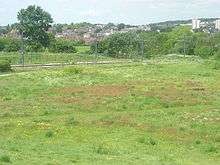
- from Harrington Road and Birkbeck
- from Church Street and Wellesey Road
- from Reeves Corner and West Croydon
- Thornton Heath Pond
- Norbury
- Streatham (connection with Thameslink)
- Streatham Hill (connection with Southern)
- Brixton (connection with Victoria line)
- from Wimbledon (follows Thameslink to Sutton)
- Wimbledon Chase
- South Merton
- Morden South
- St Helier
- Sutton Common
- West Sutton
- Sutton
- Mitcham (intersection at current stop)
- Tooting (connection with Thameslink)
- Tooting Broadway (connection with Northern line and future Crossrail 2)
Other extension proposals include Lewisham, Bromley town centre, Biggin Hill Airport/Village and a local spur/loop to penetrate further into Purley Way retail/industrial park.
Starting in the west, there are two corridors into Sutton town centre. The first, principally between Wimbledon and Sutton, was in view even before Tramlink opened: the trams were delivered with this as "line 4" on their destination blinds.
Sutton to Wimbledon
The Sutton to Wimbledon proposal utilises the existing line between Wimbledon and Morden Road, but the cramped terminus inside Wimbledon station is barely adequate for its present function. If another service is to serve Wimbledon a new terminus will be needed. Diverging from the present route, the Sutton line might adopt a segregated alignment within the highway along Morden Road, serving Morden station interchange. It would probably use Aberconway Road to reach Morden Hall Road before using the spacious St Helier Avenue as the direct route to St Helier, Rose Hill. St Helier Hospital is an important local traffic objective, despite the need to deviate from the direct route into Sutton via Angel Hill. A number of variants in Sutton Town centre are to be examined to see how the shopping centre, station and office complex can be accessed. The alignment is served by busy bus routes and would give Tramlink direct with the Northern line at Morden. A south-to-east curve may also be considered at Morden Road to permit direct links from St Helier to Mitcham and Croydon.[40]
In July 2013, Mayor Boris Johnson affirmed that there is a reasonable business case for Tramlink to cover the Wimbledon - Sutton corridor. A map has been released showing the planned route. It would leave the existing route just to the east of Morden Road and head along the A24 and A297 to Rosehill Roundabout, then the B2230 through Sutton town centre, ending at the station. A loop via St Helier Hospital and a possible extension to Royal Marsden Hospital also are shown. Stops would be at Morden Hall, Ivy Lodge, Boxley Road, Langdon Road, Middleton Road, Rosehill Roundabout, St Helier Hospital (on loop), Rosehill Park, Sutton Tennis Centre, Angel Hill, Sutton Green, High Street North, Crown Road (northbound only), St Nicholas Road (northbound only), Throwley Way (southbound only) and Sutton Station[41]
Sutton to Tooting
The other Sutton proposal, to Tooting, is more ambitious and contains many more challenges than Sutton/Wimbledon link. Apart from workshop/depot facilities and a curve required to link the line into the existing system, this extension would share no infrastructure with it. If "line 4" is realised ahead of this proposal, the Tooting line would have the St Helier to Sutton section in common. North of St Helier, the alignment is likely to fit across parkland and open space to take in the Willow Lane Industrial Estate before serving Mitcham town centre. There would be some commonality here with the short separate proposal for a spur from Mitcham Junction to Mitcham town centre. From here, the extension would seek to use the pedestrianised town centre before sharing the carriageway with all traffic in London Road south of Figge’s Marsh, with room for segregation beyond the junction with Streatham Road. The most difficult leg arises immediately the Merton/Wandsworth boundary is crossed and the most effective way of reaching Tooting Broadway from this point will stir much debate.
North and south from Croydon

To the north and south of Croydon are some busy bus corridors, which derive from earlier tram routes. These include the Purley – Croydon – Streatham corridor, which is proposed for conversion to tram operation.[42][43]
To the south of Croydon, the proposal is for the new route to diverge from the central Croydon loop and use a highway alignment, probably South End and Brighton Road, to Purley. Beyond Purley, an extension to Coulsdon will be investigated. As this would be close to the M23 motorway, a possibility would be the construction of a park and ride site. Finding a good alignment will be more difficult south of Purley, where Brighton Road is the A23 trunk road.[43]
To the north of Croydon, it is proposed to use a highway alignment based on London Road. To the south of Thornton Heath Pond, the use of a shared carriageway is a possibility. North of this point the road becomes the A23 again, but there are likely to be some opportunities for trambaan type segregation to Norbury and between Norbury and Streatham, although Norbury is a pinch point. The proposal is to terminate the line at Streatham railway station, providing an interchange to the extended East London Line.[43]
Crystal Palace extension
.jpg)
The proposed extension to Crystal Palace would have linked it to Harrington Road and Beckenham Junction, with services terminating at Crystal Palace Parade.[44] There were three options on how to get to the Parade: on-street, off-street and a mixture of the two.[45] After consultation in 2006 the off-street option was favoured, with trams running along existing railway as far as Crystal Palace Station, and then running round the western edge of Crystal Palace Park (within the current park's perimeter) to the bus terminus near the parade. The planned extension was cancelled due to a lack of funding in 2000. The plans were revived shortly after Boris Johnson's re-election as London mayor in May 2012 but six months later the plan was cancelled again.[46]
TfL had stated in 2008 that due to lack of funding the plans for this extension will not be taken forward,[47] but also says that it is committed to including new proposals for extensions to the tram as part of a future bid to Government.
Other extensions
Work currently commissioned will investigate proposals to extend to Biggin Hill, Bromley town centre, Lewisham, and Purley Way. If initial examination shows promise, further work could follow to firm up more detailed routings.[48]
Accidents and incidents
On 7 September 2008, a bus on route 468 travelled through a red traffic signal and collided with tram 2534 in George Street, Croydon causing a fatality.[49][50] The driver of the bus was convicted of causing death by dangerous driving a year later in December 2009 and was sentenced to 4 years in prison.[51]
On 13 September 2008, tram 2530 collided with a cyclist at Morden Hall Park footpath crossing between the Morden Road and Phipps Bridge tram stops. The cyclist sustained injuries and later died.[52]
On 5 April 2011, a woman tripped over and was dragged under a moving tram. She was taken to hospital in a serious condition. She is believed to have been running to catch the tram outside East Croydon Station when she tripped and fell.[53]
November 2016 derailment
On 9 November 2016, tram 2551 derailed on a sharp curved junction 180 metres (590 ft) east from the Sandilands tram stop, killing seven people and injuring at least 50 more.[54] The British Transport Police arrested the driver on suspicion of manslaughter.[55] Driver error was found to be the cause of the accident, with suspicions that the driver had a microsleep episode approaching the bend.[56] Fifteen recommendations were made.[57]
Onboard announcements
The onboard announcements are by BBC News reader (and tram enthusiast) Nicholas Owen.[58] The announcement pattern is as follows: e.g. This tram is for Wimbledon, The next stop will be Merton Park.
See also
References
- ↑ "Light Rail and Tram Statistics: England 2016/17" (PDF). Department for Transport. Archived (PDF) from the original on 9 July 2017. Retrieved 30 June 2017.
- ↑ https://tfl.gov.uk/corporate/about-tfl/what-we-do/london-trams
- ↑ "London Trams". Transport for London. Archived from the original on 8 November 2016. Retrieved 9 November 2016.
- ↑ "Croydon Tramlink Act". 1994. Archived from the original on 2 October 2012.
- ↑ "Preferred bidder selected for Croydon tram project" Rail issue 279 22 May 1996 page 15
- ↑ "Croydon buy out" Railway Gazette International April 2008 page 212
- 1 2 "TfL announces plans to take over Tramlink services". Transport for London. Archived from the original on 12 April 2008. Retrieved 18 March 2008.
- ↑ thetrainline.com
- ↑ "Croydon Tramlink". railway-technology.com. Archived from the original on 22 February 2014. Retrieved 16 December 2013.
- ↑ Railway Magazine. 148: 51. 2002. ISSN 0033-8923. Missing or empty
|title=(help) - ↑ "Flyover 1". Transport-of-delight.com. Archived from the original on 14 May 2011. Retrieved 9 May 2010.
- ↑ Wright, Andrew. "Prestigious national award plaque installed at Corfe Castle on 26th October 2008". Swanage Railway. Archived from the original on 27 September 2011. Retrieved 31 August 2011.
- ↑ Wright, Andrew. "Ex-Strategic Rail Authority Chairman officially opens Corfe Castle's historic Victorian railway footbridge on 28th April 2007". Swanage Railway. Archived from the original on 27 September 2011. Retrieved 31 August 2011.
- ↑ AnnualAccounts for year ended 31 March 2008 Transport for London page 158
- ↑ Kottegoda, Maheesha (9 October 2008). "It's green for go at Tramlink". Croydon Advertiser. Archived from the original on 9 October 2008. Retrieved 10 October 2008.
- ↑ Tramlink: Your top 10 questions answered… Poster, 1995.
- ↑ "Tram-endous boost for travellers". Transport for London. 4 April 2016. Archived from the original on 13 May 2016. Retrieved 19 November 2017.
- ↑ Transport for London, Every Journey Matters. "New tram service pattern & timetable". tfl.gov.uk. Archived from the original on 26 February 2018. Retrieved 9 May 2018.
- ↑ "Even Westfield now agree there's no need for £28m tram loop". insidecroydon.com. 14 October 2017. Archived from the original on 19 December 2017. Retrieved 9 May 2018.
- ↑ "Changes coming to tram timetable: Here's what you need to know". Croydon Guardian. Archived from the original on 6 December 2017. Retrieved 9 May 2018.
- 1 2 "London Tramlink". British Trams Online / Gareth Prior. 16 October 2016. Archived from the original on 14 November 2016. Retrieved 10 November 2016.
- ↑ "End of an era as Croydon's last red tram turns green". Archived from the original on 7 October 2010.
- ↑ "London Tramlink seeks bids for additional trams". Railway Gazette International. 31 January 2011. Archived from the original on 2 October 2012.
- ↑ Rail Magazine page 16, 'News in Brief – New Trams for Croydon' Issue 663, 9th – 22 February 2011
- 1 2 "Stadler wins London Tramlink tram order". Railway Gazette International. 18 August 2011. Archived from the original on 17 September 2011.
- 1 2 London Tramlink orders more Stadlet trams Archived 3 January 2017 at the Wayback Machine. Railway Gazette 21 August 2013
- ↑ "London Tramlink orders four new trams for Wimbledon branch". TfL Website. Transport for London. 30 August 2013. Archived from the original on 1 September 2013. Retrieved 1 September 2013.
- ↑ "Tram named in honour of Stephen Parascandolo". Cryodon Tramlink The Unofficial Site. 20 August 2007. Archived from the original on 12 August 2016. Retrieved 23 December 2016.
- ↑ "London Tramlink prepares to put new trams into service". Railway Gazette International. 15 February 2012. Archived from the original on 17 February 2012.
- ↑ "On Track Plant and Construction Traffic". Stephen Parascandolo. Archived from the original on 28 June 2016. Retrieved 10 November 2016.
- 1 2 3 4 5 6 7 "Archived copy" (PDF). Archived (PDF) from the original on 19 October 2016. Retrieved 11 July 2017.
- 1 2 "Archived copy" (PDF). Archived (PDF) from the original on 23 April 2017. Retrieved 22 April 2017.
- 1 2 3 4 5 6 7 "Archived copy" (PDF). Archived (PDF) from the original on 20 December 2016. Retrieved 15 December 2016.
- ↑ "Archived copy" (PDF). Archived (PDF) from the original on 20 December 2016. Retrieved 15 December 2016.
- ↑ https://www.croydonadvertiser.co.uk/news/croydon-news/doubt-cast-over-funding-croydon-1387988
- ↑ http://www.metro-report.com/news/single-view/view/london-tram-enhancements-included-in-growth-fund.html
- ↑ Transport for London, Every Journey Matters. "Wimbledon tram stop reopens with new platform". tfl.gov.uk. Archived from the original on 29 July 2017. Retrieved 9 May 2018.
- 1 2 3 "Archived copy" (PDF). Archived (PDF) from the original on 25 April 2017. Retrieved 11 July 2017.
- ↑ London Dockland and Croydon Tramlink Extensions Archived 13 July 2009 at the Portuguese Web Archive
- ↑ Proposals to extend the Tramlink system Archived 11 November 2007 at the Wayback Machine. Always Touch Out
- ↑ "Boris tells City Hall there is 'reasonable business case' for extending tram route to Sutton". Your Local Guardian. Archived from the original on 4 March 2016. Retrieved 9 May 2018.
- ↑ "South London Trams – Transport for Everyone – The case for extensions to Tramlink" (PDF). South London Partnership. Archived from the original (PDF) on 18 March 2009. Retrieved 2 September 2008.
- 1 2 3 "Tramlink Extensions". Croydon Tramlink – The Unofficial Site. Archived from the original on 5 June 2012. Retrieved 2 September 2008.
- ↑ "Croydon Tramlink extension to Crystal Palace". Lambeth Council Website. Lambeth Council. Retrieved 19 August 2013.
- ↑ "Crystal Palace extension options to reach the Parade" (PDF). tfl.gov.uk. Retrieved 9 May 2018.
- ↑ Austen, Ian (7 December 2012). "Crystal Palace Tramlink extension not backed by Boris Johnson despite manifesto". Croydon Advertiser. Retrieved 19 August 2013.
- ↑ Tramlink extension to Crystal Palace Archived 2 December 2008 at the Wayback Machine.
- ↑ "Tram network prepares to spread its wings across southern region". This is Local London. Archived from the original on 24 November 2007. Retrieved 16 November 2007.
- ↑ "Man killed in bus and tram crash". BBC. 7 September 2008. Archived from the original on 8 September 2008. Retrieved 8 September 2008.
- ↑ "Bus driver charged over Croydon death crash with tram". Croydon Advertiser. 23 February 2009. Archived from the original on 9 December 2009. Retrieved 9 December 2009.
- ↑ Wilson, Cherry (2 December 2009). "Bus driver found guilty of causing passenger's death". Croydon Advertiser. Archived from the original on 13 September 2012. Retrieved 7 June 2010.
- ↑ "Fatal accident at Morden Hall Park footpath crossing 13 September 2008" (PDF). RAIB. 12 March 2009. Archived (PDF) from the original on 16 December 2013. Retrieved 14 August 2013.
- ↑ Miller, Harry (5 April 2011). "Croydon woman dragged under tram in serious condition". This Is Local London. Archived from the original on 25 January 2012.
- ↑ "Croydon tram: Five dead and 50 injured after derailment". BBC London. 9 November 2016. Archived from the original on 9 November 2016. Retrieved 9 November 2016.
- ↑ "BTP | Updated statement on tram derailment - Croydon". media.btp.police.uk. "British Transport Police". Archived from the original on 10 November 2016. Retrieved 9 November 2016.
- ↑ "Croydon tram crash: Report says driver 'probably dozed off'". BBC. Retrieved 7 December 2017.
- ↑ "Overturning of a tram at Sandilands junction, Croydon 9 November 2016" (PDF). RAIB. Retrieved 7 December 2017.
- ↑ "Tramlink celebrates its seventh birthday". Archived from the original on 15 October 2008. Retrieved 3 February 2009.
Further reading
- Walter, Mike (25 March – 7 April 1998). "Next stop Croydon...". RAIL. No. 327. EMAP Apex Publications. pp. 36–37. ISSN 0953-4563. OCLC 49953699.
- "First Croydon tram arrives at brand new depot". RAIL. No. 341. EMAP Apex Publications. 7–20 October 1998. p. 14. ISSN 0953-4563. OCLC 49953699.
- Dunn, Pip (21 October – 3 November 1998). "This is the modern world!". RAIL. No. 342. EMAP Apex Publications. pp. 30–33. ISSN 0953-4563. OCLC 49953699.
External links
| Wikimedia Commons has media related to Tramlink. |
Route map:
- "Trams". Transport for London. Retrieved 5 March 2015.
